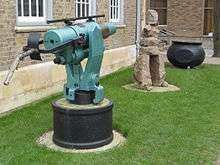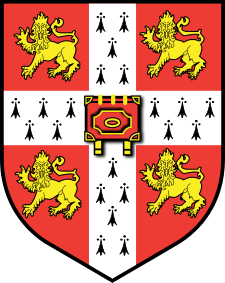Scott Polar Research Institute
 | |
| Established | 1920 |
|---|---|
| Director | Professor Julian A. Dowdeswell |
| Location |
Cambridge, United Kingdom (52°11′54.40″N 0°07′34.45″E / 52.1984444°N 0.1262361°E) |
| Website |
www |
The Scott Polar Research Institute (SPRI) is a centre for research into the polar regions and glaciology worldwide. It is a sub-department of the Department of Geography in the University of Cambridge, located on Lensfield Road in the south of Cambridge (52°11′54.40″N 0°07′34.45″E / 52.1984444°N 0.1262361°E).
Purpose


SPRI was founded by Frank Debenham in 1920 as the national memorial to Captain Robert Falcon Scott and his companions, who died on their return journey from the South Pole in 1912. It investigates issues relevant to the Arctic and Antarctic in the environmental sciences, social sciences and humanities. The institute has some 60 personnel, consisting of academic, library and support staff plus postgraduate students, associates and fellows attached to research programmes.[1]
The institute also hosts the Scientific Committee on Antarctic Research, and is part of the NERC Centre for Polar Observation and Modelling.
Resources
The Grade II listed main building (1933–34) is by Sir Herbert Baker. The small halls have shallow domed ceilings painted with the aspect of the globe from north and south poles, by MacDonald Gill.[2]
The Scott Polar Research Institute houses the world's most comprehensive polar library and archives.[3] The Institute's Thomas H. Manning Archive contains an unparalleled collection of manuscript material relating to the polar regions, research and exploration. For scientists and scholars, the library offers a collection developed since the 1920s covering all subjects relating to the Arctic, the Antarctic, and to ice and snow wherever found. For industry, it is a prime information source on such subjects as exploration and exploitation of natural resources and on the environmental implications of such activities in the polar regions; on the design of ice-strengthened shipping and selection of sea routes; and on problems of construction and transportation in cold environments. The library also offers an unrivalled resource for the needs of international relations and strategic defence.
The Picture Library contains a photograph collection from both the Arctic and Antarctic, mainly depicting the history of exploration in the polar regions, including much material from the expeditions of Scott and Shackleton. Its Thomas H. Manning Polar Archives are named in honour of the British-Canadian Arctic researcher, a university alumnus.[4] Its work includes an oral history programme which interviews people who have worked in the polar regions over the years. Due to high demand, the Polar Archives runs a booking scheme for anyone wishing to consult material.[5]
The most recent addition to the library is the Shackleton Memorial Library, which in 1999 won a regional award from the Royal Institute of British Architects.[6] This part of the building holds much of the library's Antarctic collection, as well as some of its subject-based material.
The library is part of the Inspire Libraries scheme[7] and is open to anyone with a polar interest to use for reference work and research.
The Polar Museum


SPRI operates the Polar Museum, which presents a range of objects, artworks, documents and photographs from the Institute's extensive polar collections. The collections include material related to polar history, exploration, science, art and Arctic cultures.[9][10][11]
In 2010 the renovated Polar Museum opened its doors to the public; the reopening was met with widespread acclaim and the museum was shortlisted for the Art Fund's Museum of the Year prize in 2011.[12] The museum welcomed 52,392 visitors in 2017.[13] It contains displays of Arctic art and artefacts, material from the nineteenth century search for the Northwest Passage, the Heroic Age of Antarctic Exploration (including the last letters of Captain Scott) and contemporary research and policy relating to the polar regions.
Important material cared for by the Scott Polar Research Institute and on display in the Polar Museum includes:
- A folding camera used by Robert Falcon Scott at the South Pole, 1912, on the British Antarctic Expedition 1910–13 (Terra Nova).[14]
- A reindeer-skin sleeping bag used by Captain Lawrence Oates during the journey to the South Pole on the British Antarctic Expedition 1910–13 (Terra Nova). The bag was found on 12 November 1912 by the search party looking for the polar party.[15]
- A sextant used for navigation by Captain Frank Worsley on the James Caird during the Ernest Shackleton's Imperial Trans-Antarctic Expedition 1914–16 (Endurance).[16]
The Institute is actively adding to its collection of contemporary polar art through its artist in residence scheme, managed by the Friends of SPRI, which enables an artist to travel to the Antarctic and the Arctic each year.[17]
As well as permanent exhibits, the museum regularly hosts special exhibitions and shows of modern polar art. The museum is open Tuesdays to Saturdays, 10:00 – 16:00, and admission is free.[18]
The museum is one of the eight museums and botanic garden which make up the University of Cambridge Museums consortium.[19]
Research
SPRI has several research groups.
Glaciology and Climate Change Group
This group's work involves quantifying the state of the cryosphere using remote sensing by satellites, plus accurate field measurements and computer simulations, to understand the processes in detail. In particular, the group has been able to observe the melting of the Larsen Ice Shelf, the rapid retreat of ice in western Antarctica, and increased summer melting in northern Canada. This work has contributed greatly to understanding climate change.
Glacimarine Environments Group
This group's work focuses on the dynamics of ice-sheets and delivery of sediment to the marine environment. The group uses geophysical and geological evidence gathered by icebreakers in the polar seas.
Polar Landscape and Remote Sensing Group
This group's work focuses on the processes which modify the polar and sub-polar environments, such as Arctic vegetation, and snow and ice cover. Improving techniques for measuring vegetation from satellite data is an important part of the work.
Polar Social Science and Humanities Group
This is an interdisciplinary group covering the anthropology, history and art of the Arctic. Its work includes looking at politics and environmental management in the polar regions, with particular expertise in the religion, culture and politics of the Russian North.
Directors of the Scott Polar Research Institute
- Frank Debenham (1920–46)
- William Launcelot Scott Fleming (1937–49, part time)
- Colin Bertram (1949–56, part time)
- Gordon de Quetteville Robin (1958–82)
- Terence Armstrong (Acting Director, 1982–83)
- David Drewry (1984–87)
- Peter Wadhams (1987–92)
- John Heap (1992–98)
- Keith Richards (1998–2002)
- Julian Dowdeswell (2002– )
See also
- Scott Polar Research Institute's journal Polar Record
- British Antarctic Survey
- World Data Center
- National Snow and Ice Data Center
- Scientific Committee on Antarctic Research
References
- ↑ Welcome to SPRI Scott Polar Research Institute. Accessed 28 December 2007.
- ↑ Historic England. "Scott Polar Research Institute (Grade II) (1268369)". National Heritage List for England. Retrieved 29 December 2017.
- ↑ "Scott Polar Research Institute, Cambridge » Library". www.spri.cam.ac.uk. Retrieved 14 April 2018.
- ↑ Kaufman, Michael T. (25 November 1998). "Thomas Manning, 86, Explorer Known as Lone Wolf of Arctic". The New York Times. Retrieved 20 April 2009.
- ↑ "Scott Polar Research Institute, Cambridge » Polar Archives". www.spri.cam.ac.uk. Retrieved 14 April 2018.
- ↑ The Shackleton Memorial Library Scott Polar Research Institute. Accessed 28 December 2007.
- ↑ http://inspire-libraries.org.uk/participating-libraries/?task=view&id=1558
- ↑ "Antarctic Monument is unveiled in Cambridge". BBC News. Retrieved 13 May 2016.
- ↑ "Museum Catalogue". Scott Polar Research Institute – Museum Collections. Scott Polar Research Institute, University of Cambridge. Retrieved 2 May 2018.
- ↑ "Picture Library Catalogue". Scott Polar Research Institute – Picture Library Collections. Scott Polar Research Institute, University of Cambridge. Retrieved 2 May 2018.
- ↑ "Archive Catalogue". Scott Polar Research Institute – Archive Collections. Scott Polar Research Institute, University of Cambridge. Retrieved 2 May 2018.
- ↑ Fund, Art. "Getting to know... The Polar Museum". Art Fund. Retrieved 28 April 2018.
- ↑ "ALVA – Association of Leading Visitor Attractions". www.alva.org.uk. Retrieved 18 May 2018.
- ↑ "Museum catalogue – Antarctic Collection – Camera". Scott Polar Research Institute. Scott Polar Research Institute, University of Cambridge. Retrieved 2 May 2018.
- ↑ "Museum catalogue – Antarctic Collection – Sleeping bag". Scott Polar Research Institute. Scott Polar Research Institute, University of Cambridge. Retrieved 2 May 2018.
- ↑ "Museum catalogue – Antarctic Collection – Sextant". Scott Polar Research Institute. Scott Polar Research Institute, University of Cambridge. Retrieved 2 May 2018.
- ↑ "Artists in Residence". Scott Polar Research Institute. Scott Polar Research Institute, University of Cambridge. Retrieved 2 May 2018.
- ↑ Museum Polar Museum. Accessed 9 June 2010.
- ↑ McPhee, Jo (6 August 2013). "Our Museums". www.cam.ac.uk. Retrieved 14 April 2018.
